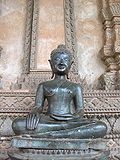Etymology[edit]
She is known by various names throughout Southeast Asia. In Khmer, she is known by her title Neang Kongheng (នាងគង្ហីង, lit. "lady princess"),[2] or as Preah Thorani' (ព្រះធរណី).[3] In Burmese, she is known as Wathondare (ဝသုန္ဓရေ) or Wathondara(ဝသုန္ဓရာ) (from Pali: vasundharā) and variously transliterated as Wathundari, Wathundaye, Vasundari, etc.[2] In Thai and other Tai languages, she is known as Thorani (from Pali: dhāraṇī, lit. 'ground, earth"')[4] in various appellations, including Nang Thorani (นางธรณี), Mae Thorani (แม่ธรณี), and Phra Mae Thorani (พระแม่ธรณี).[2]
Iconography and symbology[edit]

Images of Phra Mae Thorani are common in shrines and Buddhist temples of Burma, Cambodia, Thailand and Laos. According to Buddhist myths, Phra Mae Thorani is personified as a young woman wringing the cool waters of detachment out of her hair to drown Mara, the demon sent to tempt Gautama Buddha as he meditated under the Bodhi Tree.
The Bodhisattva was sitting in meditation on his throne under the Bodhi Tree, Mara, the Evil One, was jealous and wanted to stop him from reaching enlightenment. Accompanied by his warriors, wild animals and his daughters, he tried to drive the Bodhisattva from his throne. All the gods were terrified and ran away, leaving the Bodhisattva alone to face Mara's challenge. The Bodhisattva stretched down his right hand and touched the earth, summoning her to be his witness. The earth deity in the form of a beautiful woman rose up from underneath the throne, and affirmed the Bodhisattva's right to occupy the vajrisana. She twisted her long hair, and torrents of water collected there from the innumerable donative libations of the Buddha over the ages created a flood. The flood washed away Mara and his army, and the Bodhisattva was freed to reach enlightenment.
— A Study of the History and Cult of the Buddhist Earth Deity in Mainland Southeast Asia[5]
In temple murals, Phra Mae Thorani is often depicted with the Buddha in the mudra known as calling the earth to witness. The waters flowing forth from her long hair wash away the armies of Mara and symbolize the water of the bodhisattva's perfection of generosity (dana parami).
Calling the earth to witness[edit]
In the iconography of Gautama Buddha in Laos and Thailand, "touching the earth" mudra (Maravijaya Attitude) refers to the Buddha's pointing towards the earth to summon the Earth Goddess to come to his assistance in obtaining enlightenment by witnessing to his past good deeds.[6]
Buddhist water libation[edit]
In Buddhism in Burma, the water ceremony (yay zet cha), which involves the ceremonial pouring of water from a glass into a vase, drop by drop, concludes most Buddhist ceremonies including donation celebrations and feasts. This ceremonial libation is done to share the accrued merit with all other living beings in all 31 planes of existence.[7] While the water is poured, a confession of faith, called the hsu taung imaya dhammanu, is recited and led by the monks.[8] Then, the merit is distributed by the donors, called ahmya wei, by saying Ahmya ahmya ahmya yu daw mu gya ba gon law three times, with the audience responding thadu, Pali for "well done." The earth goddess, known in Burmese as Wathondara (ဝသုန္ဒရာ) or Wathondare (ဝသုန္ဒရေ), is invoked to witness these meritorious deeds.[8] Afterward, the libated water is poured on soil outside, to return the water to the goddess.



